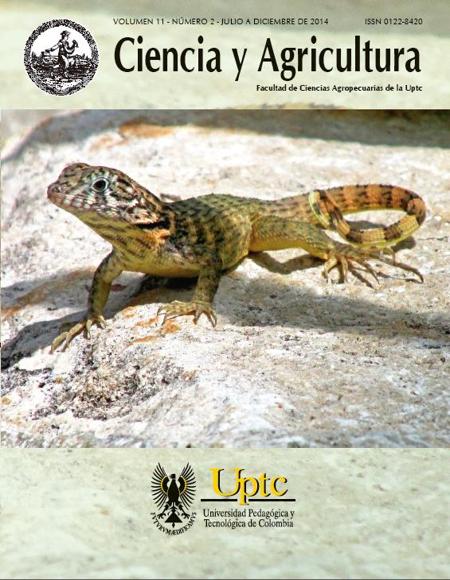Effect of levels of metabolizable energy and protein on the zootechnical performance of laying quails

Abstract
This study, carried out in the University of the Llanos, aimed to determine the optimal level of metabolizable energy and protein quail (Coturnix japonica) in laying phase. We used 480 quails 10 weeks old and 94±10 g of initial weight, distributed in a completely randomized experimental design, 4x4 factorial arrangement, with four levels of metabolizable energy (2750, 2850, 2950 and 3050 kcal EM.kg1), and four levels of crude protein (17.5, 19.0, 20.5 and 22.0%), with three replicates and 10 birds. The trial lasted 24 weeks, during which water and food were supplied at will. The results were processed in the SAEG program (2007), subjected to analysis of variance and polynomial regression. The results showed no interaction between the levels of metabolizable energy and protein, which means the factors acted independently. Analyzing each factor, a quadratic influence (p <0.05) was observed on egg production. The egg production was increased (91%) to the level of 2750 kcal of EM.kg1 and 20.5% crude protein. These levels provided a feed conversion related dozen eggs/kg was of 0.338, the value of egg mass of 2.852 with 3050 kcal EM.kg-1 and 19% crude protein. The equations y = -0.0038x2 + 0.1456x - 0.5771, y = R2 = 75.7 -8E-05x2 + 0.4466x-533.05, R2 = 0.89, allow to estimate the requirements of crude protein (2791 kcal EM.kg-1) and metabolizable energy (19.16%) for egg production.Keywords
feed conversion, coturnix japonica, eggs production, nutrients requirements.
References
- Teixeira BB, Pires AV, Veloso RC, Gonçalves FM, Drumond ESC, Pinheiro SRF, Performance of meattype quails subjected the different levels of crude protein and metabolizable energy. Ciência Rural, 2013; 43 (3), 524-529.
- National Research Council, NRC. Nutrients requirements of poultry. 9 ed. Washington, D. C. National Academy Press, 1994. 155 p.
- Rostagno HS, Albino LFT, Donzele JL, Gomes PC, Oliveira RF, Lopes CD y otros. Tabelas Brasileiras para Aves e Suínos - Composição de Alimentos e Exigências Nutricionais (Tercera edición ed.), 2011.
- Campos A, Salguero S, Albino L, Rostagno H. Aminoácidos en la nutrición de pollos de engorde: Proteína ideal. En: III CLANA. México: Congreso del Colegio Latino-Americano de Nutrición Animal, 2008, 16 p.
- Salvador E, Guevara V. Development and validation of a model to predict the optimum requirement of essential amino acids and performance in commercial laying hens. Rev. Investig. Vet. Perú; 2013, 24(3): 257-263.
- Jordão Filho J, Silva JHV, Costa FGP, Nilva Kazue Sakomura NK, Silva CT, Chagas NA. Prediction equations to estimate the demand of energy and crude protein for maintenance, gain and egg production for laying Japanese quails. R. Bras. Zootec, 2011; 40(11): 2423-2430.
- Barreto SLT, Sousa QBJ, Brito OC, Tie UR, De Araujo MS, Coimbra JSR. Níveis de energia metabolizável para codornas japonesas na fase inicial de postura. Rev Bras Zootec, 2007; 36 (1): 79-85.
- Lopes IRV, Fuentes MFF, Freitas ER, Soares MB, Ribeiro PS. Effect of cage density and metabolizable energy level of the diet on performance of Japanese quails. Revista Ciência Agronômica, 2006; 37(3): 369-375.
- Lima RC, Costa FGP, Goulart CC, Cavalcante LE, Freitas ER, Silva JHV, Dantas LS, Rodrigues VP. Nutritional requirement of crude protein for japanese quail (Coturnix coturnix japonica) in the production phase Arq. Bras. Med. Vet. Zootec, 2014; 66(4): 1234-1242.
- Olgun O, Yıldız AÖ. Effects of Diets Including Different Levels of Protein and Supplemented with Probiotic-Enzyme on erformance and Eggshell Quality of Laying Quails. Turkish Journal of Agriculture - Food Science And Technology, 2014; 2(5): 236-241.
- Guimarães MCC, Furtado DA , Nascimento JWB, Tota LCA , Silva CM, Lopes KBP. Efeito da estação do ano sobre o desempenho produtivo de codornas no semiárido paraibano. Revista Brasileira de Engenharia Agrícola e Ambiental, 2014; 18(2): 231-237.
- Moura GS, Sergio Barreto SLT, Donzele JL, Hosoda LR, Pena GM, Angelini MS. Dietas de diferentes densidades energéticas mantendo constante a relação energia metabolizável: nutrientes para codornas japonesas em postura. R. Bras. Zootec, 2008; 37(9): 1628-1633.
- Zita L, Ledvinka Z, Tumova E, Klesalova L. Technological quality of eggs in relation to the age of laying hens and Japanese quails. R. Bras. Zootec, 2012; 41(9): 2079-2084.
- Ghazvinian K, Irani M, Jamshidi R, Mirzaei-Aghsaghali A, Siadati AS, Javaheri-Vaighan A. The effect of energy to protein ratio on production performance and characteristics of Japanese quail eggs. Annals of Biological Research, 2011; 2(2): 122-128.
- Silva JHV, Jordao Filho J, Costa, FGP, Lacerda PB, Vargas DGV, Lima MR. Exigências nutricionais de codornas. Rev. Bras. Saúde Prod. Anim., 2012; 13(3): 775-790.
Downloads
Download data is not yet available.